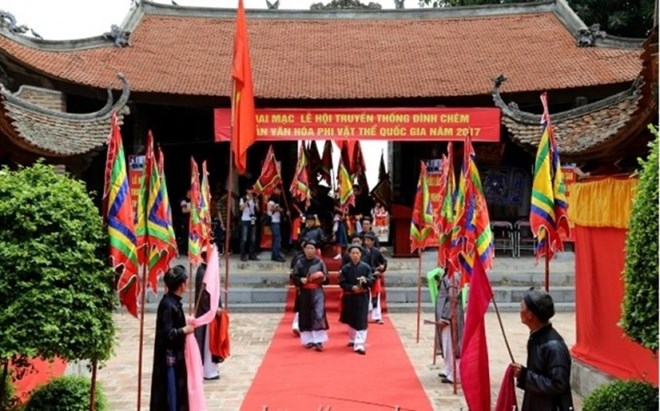



The festival
gathers various beliefs including Taoism, Buddhism and Mother Goddess (Photo:
laodongthudo.vn)
Thuy was speaking at a ceremony hosted by Bac Tu Liem district to
name Chem Communal House a Special National Relic Site.
"With its unique layout and history, the architecture cannot be found in other
communal houses and temples in the region,” she added.
The Chem Communal House was built around 1,200 years ago, making it one of the
oldest buildings in Vietnam.
The house is dedicated to Thuong Dang Thien Vuong Ly Ong Trong who served under
King Hung Due Vuong (the last branch of the Hong Bang dynasty - 408
to 258 BC), and An Duong Vuong, who ruled over the kingdom of Au Lac (now
Vietnam) from 257 to 207 BC.
The communal house has been a spiritual meeting place over the centuries on the
banks of the Hong (Red) River, and residents of Thuy Phuong commune now worship
there.
According to Do Manh Tuan, Chairman of the district People’s Committee, there
are 135 relic sites in the area. "Chem Communal House has the most notable
architecture and carvings,” he said.
"It features the most delicate carving skills within its design,” commented
researcher Nguyen Thanh Vu from the ministry. "The communal house has been a
valuable source for anyone who wants to study the history, culture and customs
of the ancient land to the west of Thang Long Citadel.”
The house is still home to 16 books written in the Han Chinese script, three
royal decrees issued by Nguyen kings, four ancient stone steles, 10 statues,
dozens of horizontal lacquered boards and parallel sentences, two bronze bells
and other valuable objects.
There is also an incense burner that dates back thousands of years and bronze
rain gutters made during King Le Hien Tong’s reign (1740-1786).
"I’ve instructed authorities to draft a plan to preserve the house,” said Thuy.
"The management board needs to install a fence around the site prevent
neighbours from encroaching on it. It also needs to protect the ancient objects
housed at the site and use financial contributions from individuals and
agencies to repair the house,” she added.
The Chem Communal House festival is among the most ancient customs in the
capital, and is held in middle of the 5th lunar month.
The festival attracts various beliefs including Taoism, Buddhism and Mother
Goddess.
"The festival should be managed by the local community, and local authorities
should ensure security and safety for the event,” Thuy said.
Source: VNA